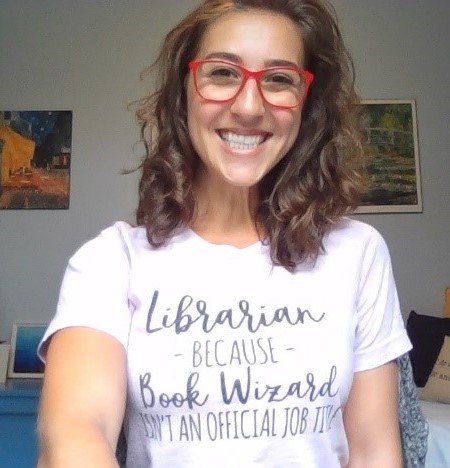On this week’s Princh Library Blog post guest writer Chelsea Humphries shares her advice on how to incorporate mindfulness, the act of focusing on the present moment, into libraries.
How to incorporate mindfulness practices in libraries
Mindfulness is a simple concept at its core: it is the act of intentionally focusing on one’s experience of the present moment without judgement. Mindfulness practices are widespread, and can take on many forms, including, perhaps most traditionally, meditation, prayer, yoga, physical activities like running and swimming, journaling, crafting, and other hobbies. Such practices and related contemplative activities have become increasingly mainstream within the last few years with acclaim of many benefits. To no surprise, they are finding their way into libraries. As traditional spaces for contemplation, libraries are among the newest spaces in which these practices are finding a home.
As both an academic librarian and a yoga instructor, I am interested in the overlap between libraries and mindfulness practices. I have actively developed programming and conduct research in this niche, as I believe that libraries, as spaces for contemplation and curiosity, are natural places in which mindfulness practices can and should be explored. The following are a few suggestions, rooted in my experiences, for how best to incorporate mindfulness practices in your library, be it public or academic.
Making the most of existing resources and spaces
Libraries, at their core, are about sharing resources. A simple way to support mindfulness practices in your library is creating book displays on themes related to mindfulness, meditation, yoga, and other contemplative practices. In a digital setting, this can be replicated by digital displays, blog posts, and social media posts highlighting the more mindful resources in your library’s collection.
Collections of varied and more unconventional materials can also be built up in support of mindfulness practices. Lending out yoga mats, meditation cushions, and other props, alongside recorded meditations or curated playlists of meditations, may make the exploration of mindfulness practices more accessible for patrons, both within and outside of the library. (See an example lending program here from the University of Toronto.)
Many libraries are now building meditation and prayer rooms into their spaces. These rooms are dedicated to quiet contemplative practices and may support mindful activities like yoga classes, too. Creating these spaces and stocking them with yoga mats and cushions may facilitate mindfulness practices. When patrons see these spaces and resources, they may be inspired and curious to learn more about the practices that they support. If you build it, they will come.
Planning activities and events
Beginner-level yoga classes and mediation classes led by qualified library staff or by community partners (like instructors from nearby yoga studios), can be a great entry-point for patrons to mindfulness practices. Insofar as libraries are spaces in which individuals are already comfortable with seeking out the unknown, being spaces of searching and discovery, libraries may be less intimidating (and more affordable) spaces than yoga studios and gyms for individuals who are new to such practices. Information-seeking related to mindfulness practices likely already happens in the library as patrons search for print and e-resources on related subjects— but this information-seeking can also include experiential learning.
Mindfulness practices like yoga and meditation classes can be a great way to foster community engagement and outreach in the library, too. Hosting regular beginner-level classes like these (even virtually, like my “Library Yoga” program during the COVID-19 pandemic) can support students experiencing stress during the academic year and can help build relationships between all patrons and library staff. They can also provide the opportunity for patrons to learn more about their community. Inviting guest experts and instructors to run sessions may introduce patrons to services and spaces in which they can further their mindfulness practices beyond the library, while also offering essential outreach opportunities to these experts and instructors. Consider partnering with local meditation centres and yoga studios, as two examples. The library can be a hub for community exploration of mindfulness in partnership with other organizations.
Special events, like mindfulness fairs, offer a larger-scale opportunity for community building. Booths from local services in the wellness industry, events like yoga classes and meditation sessions, and mindful crafting and hobby activities can bring in new and regular patrons and introduce them to mindfulness practices and resources in the library and their community that they may not have known before.
Leading by example
Mindfulness practices are not solely for patrons. Library staff can benefit from them, too. Simply holding space for conversations about mindfulness practices can be an excellent way of team building. Reading groups, meditation circles, and chair yoga sessions may also support staff wellbeing, which, in turn, improves morale and service. Even small, individual moments of mindfulness while eating lunch, or taking a short break to mindfully step outside and notice the sensations of the breeze and the warmth of the sun can make an enormous difference. Personal experience with mindfulness practices, no matter how small, may help staff feel more equipped to share mindfulness practices and resources with their patrons, too.
Incorporating mindfulness practices into our libraries stands to improve community engagement and staff wellbeing. Mindfulness programming in libraries can also encourage staff and patrons alike to consider mindfulness as an essential component of daily life. When mindfulness is brought into the library, it becomes a part of our work, our studies, and our recreation. Mindfulness practices are not confined to a particular time or space; they can meet us anywhere. They can exist in moments of solitude, in moments of service, and in moments of discovery—all of which have a home in the library.

Chelsea Humphries
Chelsea Humphries is an academic librarian at Brock University and a yoga instructor, who passionately believes that all libraries are spaces of discovery, capable of supporting community wellbeing. You can learn more about her on her website, and can connect with her on Instagram, Twitter, and YouTube.
Recent posts
Library Spaces & Clean Air: The Impact of Printing Choices on Indoor Environment
In this week's Princh Library Blog, guest writer Nina Grant talks about something that's always present, but rarely thought about; air, or [...]
Library Advocacy: How Individuals and Businesses Can Contribute to Library Resources
In this week’s Princh Library Blog post, guest writer Sam L. Bowman explores how both individuals and businesses can practice library advocacy [...]






Leave A Comment